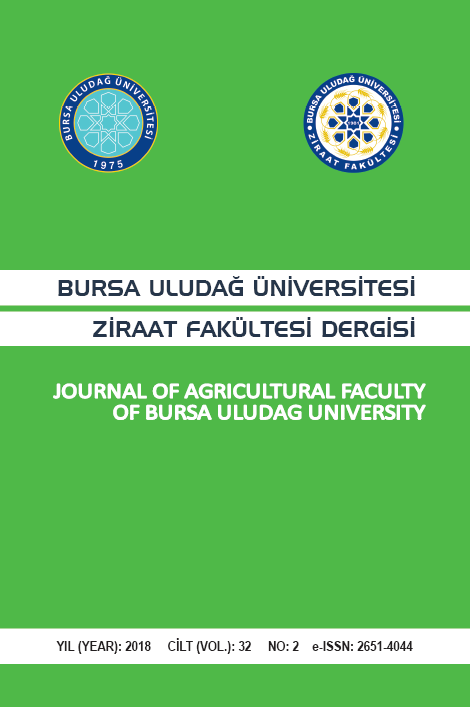Uludağ Üniversitesi Ziraat Fakültesi Amfi Çatısının Güneş Elektriği Potansiyelinin Tahminlenmesi
Gölgelenme, güneş enerjisi, simülasyon.
Estimating Solar Electricity Potential of Uludag University Agricultural Faculty Lecture Theater Rooftop
Shading, simulation, solar energy,
___
- Gebremedhen, Y.B. 2014. Determination of optimum fixed and adjustable tilt angles for solar collectors by using typical meteorological year data for Turkey. International Journal of Renewable Energy Research, 4(4): 924-928.
- Işik, A.H., Ş. Erden and M. İmeryüz, 2015. Design of the solar energy system in ITU faculty of electric and electronics. International Conference on Renewable Energy Research and Applications, 22-25 November 2015, Palermo, Italy, p: 867-871.
- Lalwani, M., Kothari, D.P. and Singh, M. 2010. Investigation of solar photovoltaic simulation softwares. International Journal of Applied Engineering Research, 1(3): 585-601.
- Mangan, S.D. ve Oral, G.K. 2013. Türkiye’nin farklı iklim bölgelerinde bir konut binasının enerji etkin iyileştirilmesi. 11. Ulusal Tesisat Mühendisliği Kongresi, 17-20 Nisan 2013, İzmir, Türkiye, p: 921-931.
- Maturi, L., W. Sparber, B. Kofler and W. Bresciani. 2010. Analysis and monitoring results of a BIPV system in northern Italy. 25th European Photovoltaic Solar Energy Conference and Exhibition, 6-10 September 2010, Valencia, Spain, p:1-4.
- Patarau, T., D. Petreus, and R. Etz. 2015. Analysis and optimization of a geothermal, biomass, solar hybrid system: An application of PV*Sol software. 38th International Spring Seminar on Electronics Technology, 6-10 May 2015, Eger, Hungary, p: 370-375.
- Sharma, D.K., Verma, V. and Singh, A.P. 2014. Review and analysis of solar photovoltaic softwares. International Journal of Current Engineering and Technology, 4(2): 725-731.
- Srpak, D., and D. Pajan. 2016. The impact of module shading and azimuth on solar power plant production. In 25. Mednarodno Posavetovanje" Komunalna Energetika 2016", 10-12 May 2016, Maribor, Slovenia, p:1-10.
- Yayın Aralığı: Yılda 2 Sayı
- Başlangıç: 1982
- Yayıncı: Bursa Uludağ Üniversitesi
Uludağ Üniversitesi Ziraat Fakültesi Amfi Çatısının Güneş Elektriği Potansiyelinin Tahminlenmesi
Kültür Mantarı Dilimlerinin Kurutulmasında Isı Pompalı Sisteminin Enerji Performansının İncelenmesi
Tarımda Bilgi Sistemleri; Bursa İli Örneği
İsmail Bülent GÜRBÜZ, Fikret BAYAR
Tohum Uygulamalarının Soğan (Allium cepa L.) Tohumunun Bazı Fiziksel ve Mekanik Özelliklerine Etkisi
Zeynep Dumanoğlu, Bülent Çakmak
Atdişi Mısır (Zea mays indentata Sturt.) Genotiplerinde Verim ve Verim Unsurlarının Genetik Analizi
Tuğçe HALİL, Canan Ece TAMER, Azime Özkan KARABACAK
Peyzaj Mimarlığı Eğitiminde Temel Tasarım ve Görsel Algı
Genetiği Değiştirilmiş Tarım Ürünlerinin Küresel Düzeyde Olası Etkileri
Seda YILMAZ ÇEBİ, Prof. Dr. Emine OLHAN
Tarımda Su Kalitesi ve Su Kirliliğinin Önemi: Bursa Nilüfer Çayı Örneği
